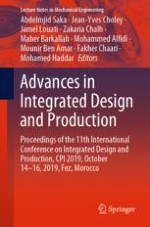2021 | Buch
Advances in Integrated Design and Production
Proceedings of the 11th International Conference on Integrated Design and Production, CPI 2019, October 14-16, 2019, Fez, Morocco
herausgegeben von: Prof. Abdelmjid Saka, Prof. Jean-Yves Choley, Prof. Jamel Louati, Prof. Zakaria Chalh, Prof. Maher Barkallah, Mohammed Alfidi, Prof. Mounir Ben Amar, Prof. Fakher Chaari, Prof. Mohamed Haddar
Verlag: Springer International Publishing
Buchreihe : Lecture Notes in Mechanical Engineering
